Teacher's Book and eBook














































































































A
DIGITAL SAMPLE
Jeanne Perrett
Your course comes with eBooks and digital resources on the Pearson English Portal.
To access the Pearson English Portal and eBooks:
1 Go to pearsonenglish.com/login
2 Sign in or create an account.
3 Once signed in, follow the on-screen instructions to add a product and use the access code below.
ACCESS CODE
This code can only be used once and the user subscription is valid for 36 months from the date of registration.
Need help?
Go to MyPearsonHelp.com/portal for help, training and technical support.
DIGITAL SAMPLE
1 1 Hello! 21 2 M y school 39 3 M y family 57 4 M y bod y 75 5 My home 93 6 My p ets 111 Phonics and letters 183 8 My food 147 9 My clothes 165 2 4 6 8 13 14 18 16 129 7 My toys Scope and sequence Welcome! Component overview Unit walkthrough Time guidelines Classroom management Games bank Course features Contents Introduction Lesson notes
Scope and sequence
Lesson 1 Vocabulary
Lesson 2 Grammar
Lesson 3 Feelings
Lesson 4 Colors & Numbers
Lesson 5A Storytime
hello, goodbye: hello, goodbye I'm (Danny ) I'm happy green Let's be friends!
School things: book, chair, crayon, table, teacher My (crayon ) I'm scared one Let’s go to school!
Family: baby, brother, daddy, mommy, sister This is my (mommy ) I'm upset red We love you, Jack-Jack!
Body: face, hand, head, leg, tummy This is my/your (head ) I'm excited two Let's play with Woody!
Home: bathroom, bedroom, kitchen, living room, yard I have a (yard ) I'm tired blue Play a lot, sleep well!
Animals: bird, cat, dog, fish, mouse I have a (dog ) I'm curious three Russell loves animals
Toys: ball, blocks, car, doll, teddy bear I like my (ball ) I'm sad four Boo shares toys
Food: apple, banana, cheese, sandwich, water I like (cheese ) I'm hungry yellow Olaf likes picnics!
Clothes: coat, dress, hat, shirt, T-shirt It's a (hat ). It's (red ).I'm proud five Dumbo gets dressed
1 5 2 6 3 7 4 8 9 2
New receptive language
What's your name?
What's this? Is it a ...? It's ... Who's this? Is this your …? What's wrong? What's this? How many …?
What's this? Is it (color)? What color? What's this? What do you have? How many ...? What's this? Where's the ...? How many ...? Do you like ...? What color? What's this? What color is it?
3
Lesson 5B Values Lesson 6 Real world Lesson 7 Review Disney movie lesson Phonics and letters I'm friendlyHello and goodbyeMake: Happy dwarf mask Finding Nemo Gg, goodbye I listenOur schools Make: Morty and Ferdie's classroom and pencil-topper puppets Toy Story 4 Tt, teacher I love my familyOur families Make: The Incredibles family picture frame Inside Out Mm, mommy I'm active We are active Make: Woody and Jessie puppets Pinocchio Hh, head I sleep well Our homes Make: rooms matching game Up Kk, kitchen I'm kind to animalsOur animalsMake: Up jigsaw puzzle Sleeping Beauty Ff, fish I share my toys Our toys Make: Monsters, Inc. pairs game Frozen Bb, ball I eat healthy food Our food Make: Frozen lunchbox and food Brave Ss, sandwich Be yourself Our clothesMake: Dress-up Dumbo Zootopia Dd, dress
Welcome!
Introduction
My Disney Stars and Friends is a pre-primary course for children aged 3 to 5 which brings together the wonder and engagement of Disney stories, a focus on future skills, and classroom tools which make teaching fun, easy, and accessible to young learners. The course is based on the following principles:
Engaged children will learn better
In partnering with Disney, we have created a course that will engage students and help them build a solid foundation for learning English.
The Disney characters are instantly recognizable and will help establish a known context for new language, making children feel at ease and ready to learn. Each unit focuses on a different set of characters, giving the course a broad appeal and keeping the content fresh and exciting. This will help students focus on the lesson, stay on task, and retain what they have learned.
Children love listening to stories, and this course features a two-page, originally-written Disney story in each unit. These stories can be read by the teacher, but are accompanied by rich audio recordings which help bring the stories to life and can also provide a model for less-confident teachers. The stories naturally lend themselves to the development of soft skills and values.
Target language is also reviewed in real-world contexts through photographs and listening activities. The photographs are often taken from a child’s perspective, showing students a view of the topic as they would see it themselves.
Soft skills are key to early-years learning
My Disney Stars and Friends helps develop selfawareness, social awareness, and persistence and growth skills, in addition to language learning. These skills are likely to be in high demand in the future, so we refer to them as Future Skills Students who begin to develop these skills from an early age will be better equipped for personal and academic success and the workplaces of tomorrow.
My Disney Stars and Friends focuses on developing the following future skills:
• Self-awareness: Students begin to identify feelings and recognize how these feelings affect their own behavior.
• Social awareness: Students learn to identify the feelings of others and understand that people are different, and have different opinions and perspectives.
• Persistence and growth: Students begin to work at tasks for increasing periods of time and identify things that are challenging and interesting. These future skills are woven into every lesson of the course. Each unit focuses on a new feeling, which children learn to recognize in themselves, the characters, and their friends. The feelings are discussed in a dedicated lesson, but also through chants, stories, and posters throughout the whole unit. As students learn to recognize these feelings in others, they are encouraged to treat them with understanding and respect.
The course also focuses on helping students stay on task, maintain effort, and begin to understand that some tasks may be easier or more difficult.
It is useful to discuss this with students openly in a simple way, for example, by asking them after completing the task if it was easy or fun.
The Future Skills addressed in each lesson are listed in the Lesson overview information, and then signposted with the icon and explained in the relevant place in the lesson notes themselves. Where the same aspect of a particular Future Skill has been surfaced in exactly the same way in a previous unit, there is an icon, but no explanation.
This focus on future skills and making children feel comfortable and emotionally supported will foster an atmosphere in which children feel safe and confident. This in turn will help them progress with their learning.
The approach to developing all future skills stems from Pearson’s Personal and Social Capabilities Framework, which also supports the development of 21st-century skills, such as collaboration, creativity, and critical thinking.
Children need routines
For preschool students of English, everything is new: a new language, a new school, a new teacher, and new friends. Introducing routines in their English lessons will help them feel safe and confident, in addition to making the classes easier to manage.
The teaching notes for every lesson suggest a very clear and repetitive structure: opening, Circle time, Book time, and closing the lesson. Each lesson follows the same pattern in every unit, so both you and the students know exactly what to expect.
4
The course also includes songs to further help continuity of lesson structure and facilitate transitioning between lesson stages. Suggestions for establishing routines in the classroom can be found in Classroom management on page 14.
Teachers need flexibility
This course provides a variety of options and pathways through the material, so you can tailor your approach to your students’ needs and your teaching context. These scenarios are listed in the Time guidelines section on page 13.
Every Student’s Book and Teacher’s Book includes an access code to digital resources, allowing a paper-based or blended approach. The digital resources include the Presentation Tool for the teacher, as well as eBooks for students, so teaching can be done remotely if necessary.
Teachers need easy-to-use materials
This Teacher’s Book has been designed by teachers, for teachers, with the aim of it being as visual and easy-to-use as possible. You can instantly see the unit and lesson objectives, where you are, and what to do even if you need to adjust your plans at the last minute. The Teacher Talk feature will help you get the most out of the material and the students, using the clearest and most concise instructions possible. This feature could be particularly useful when talking about abstract ideas like feelings and values in a way that facilitates both students’ understanding and successful task completion.
Global Scale of English (GSE)
My Disney Stars and Friends has been built on the Global Scale of English. You can see the range of objectives for each level on the cover of the coursebooks. This Teacher’s Book provides you with the key GSE objectives covered in each unit and each lesson. The full list of objectives can be
found in the Teacher Mapping Booklets which accompany the course.
The GSE is a standardized, granular scale, from 10 to 90, which measures English language proficiency. Unlike other frameworks which describe attainment in broad bands, the GSE identifies what a learner can do at each point on the scale across skills. The scale is designed to give a more granular insight into learning progress.
Understanding where your students are on the scale will help you select materials with the right level of support and challenge for your students to help them progress.
The GSE ranges for My Disney Stars and Friends are as follows:
• Level 1: 10–16
• Level 2: 11–17
• Level 3: 12–18
Teaching preschool students
Pre-literacy
My Disney Stars and Friends reinforces the development of pre-literacy skills, which are an important part of a child’s early learning.
The unit stories resemble stories encountered in picture books. Through following the frames, students learn the traditional English left-to-right reading path.
Both the Student’s Book and Workbook help develop fine motor skills, as well as hand-eye coordination, by providing activities which focus on matching, tracing, coloring, drawing, manipulating stickers, and craft projects.
Preschoolers may only just be beginning to discover sound-symbol relationships in their first language. As some teachers may not wish to teach phonics at such an early age, the
Phonics lessons are located at the back of both the Student’s Book and Workbook. My Disney Stars and Friends takes a gradual approach to introducing sound-symbol correspondences. In Level 1, children focus on the initial sound of the word and are not expected to recognize letters but can color them and become familiar with their shapes. Additional resources for word recognition and tracing are provided online.
Mathematical skills
My Disney Stars and Friends introduces children to basic concepts in math such as numbers and shapes, counting, and recognition of patterns, sizes, similarities, and differences. Students will be engaged through exciting visuals, audio and games.
Music and movement
Music and movement are key to learning new language and helping manage levels of energy and focus in the classroom. Chants and songs throughout each unit provide language consolidation for core vocabulary and structures, while encouraging students to be active and interpret the music in their own way. Toolkit songs will help mark routines at key stages of the lesson, improve focus, or release excess energy.
The grammar song in every unit is available as a video with movement, so children can act out the songs following the routines.
Craft activities
Children of pre-primary age need to develop their motor skills by engaging in a variety of craft activities. Lesson 7 of every unit reviews the target language through a simple, unit-themed project, which reviews the material in a fun and creative way. The projects require few craft materials and little cleaning up afterwards. There are additional suggestions for craft activities throughout the teaching notes.
5
Component overview















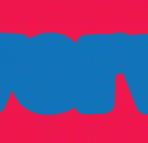









































































































1 Plan 2 Teach



In this Teacher’s Book you will find everything you need to teach with My Disney Stars and Friends. It includes comprehensive and easy-to-follow teaching notes, answers, extra activities and ideas, a games bank, audio scripts, and video scripts.
The Digital Resources that come with the Teacher’s Book provide you with all the tools you need to run a blended or hybrid lesson, plus additional reading and writing practice.
The Student’s Book is designed for use in the class, with the teacher. It presents and practices all the new material, and includes stickers, simple press-out projects, and an access code to the Student’s Book eBook and Digital Resources for parents or carers.

The Workbook provides additional practice for all the language introduced in the Student’s Book. While it can be used in the classroom, some teachers may ask students to complete certain activities at home, depending on the situation.



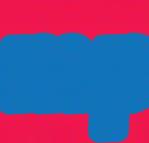
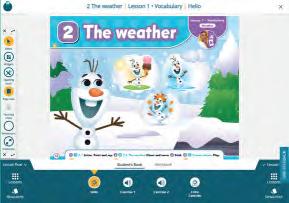
Using the Pearson English Portal, teachers can present the student’s components on screen and access interactive games, audio, and video with a simple click of a button. Access to the Presentation Tool is provided with every Teacher’s Book.





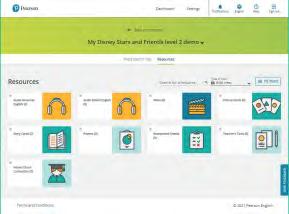

6
ATeacher's Book and eBook Jeanne Perrett CVR DISNEY S&F TB1 PESA.indd 21/07/2022 15:36 STUDENT'S BOOK and eBook WITH DIGITAL RESOURCES
AJeanne Perrett CVR DISNEY S&F SB1 PESA.indd 21/07/2022 15:13
Picture Cards
Picture Cards help present and practice all key vocabulary of each level.
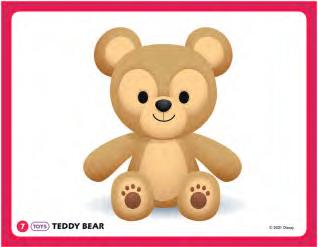
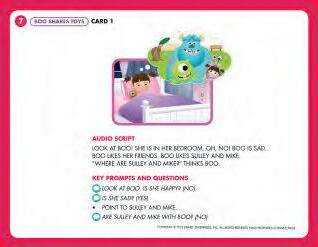
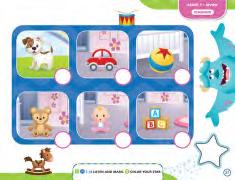

Story Cards
Story Cards help present and revisit unit stories. Each card shows one frame of a story on the front, and on the back you will find the audio script, helpful prompts, and concept-checking questions to help you get the most out of the stories.
Posters
Posters on feelings, values, weather, numbers, shapes, and colors serve as large and engaging visual references which you can use in every lesson.
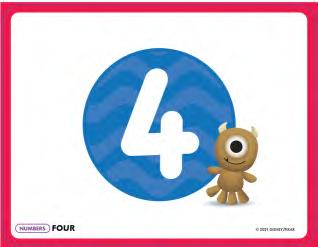

FEELINGS 1
3 Practice at home 4 Assessment
Digital Resources for parents or carers
Parents or carers can access songs, videos, and stories to revisit the material with children at home.
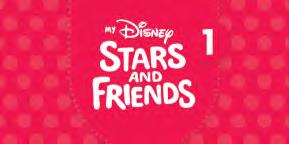

Access to the Pearson English Platform is provided via a code included in every Student’s Book.
For very young learners, we suggest using ongoing informal assessment, recording progress and possible areas for improvement. Each unit ends with a review lesson which reviews all the new material and provides an opportunity to evaluate what children have retained. Observation sheets can be found in the teacher’s digital resources.
The course comes with a Mickey Mouse puppet to bring more engagement to the classroom. The teacher’s notes suggest ways to use the puppet to introduce every new lesson.
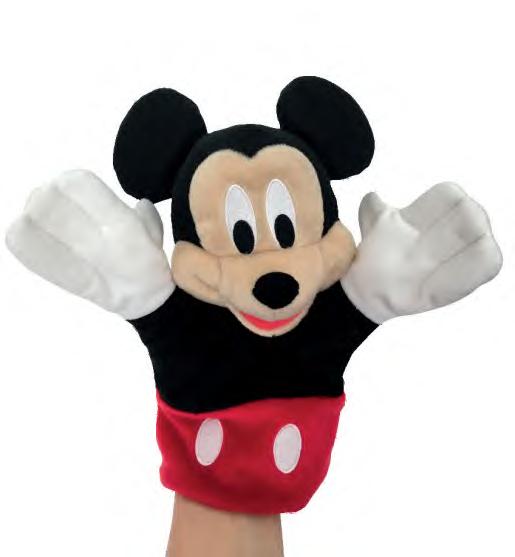
7
I’M HAPPY I’M SAD I’M EXCITEDI’M TIRED I’M HUNGRYI’M PROUD I’M CURIOUS I’M SCAREDI’M UPSET COPYRIGHT 2021 DISNEY ENTERPRISES, INC. RIGHTS RESERVED. PIXAR PROPERTIES DISNEY/PIXAR.
Unit walkthrough
Lesson 1 introduces and practices vocabulary
New language is introduced in the context of a Disney scene which instantly engages students
Students learn new language through a variety of learning modes which engage them and develop them holistically
A free-play sticker develops fine motor skills and creativity
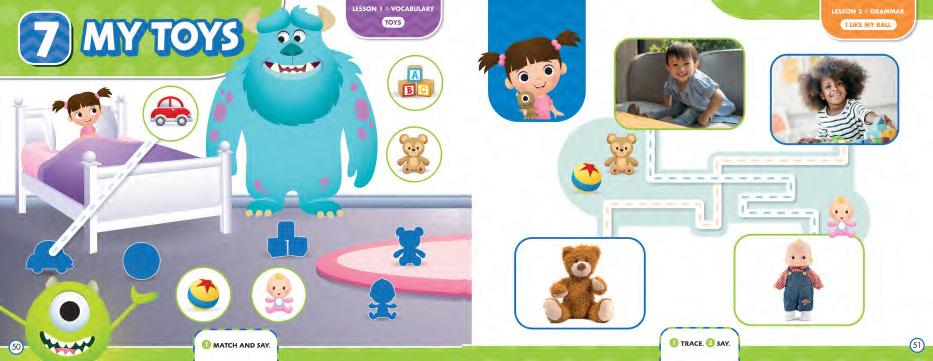
Lesson 2 introduces the core grammar structure of the unit while recycling the vocabulary from Lesson 1
The new structure is introduced in the context of real-world children

Students learn the new structure with a video action song, making it easier for them to retain language. The song is also available in audio format
Students practice new language through a variety of learning modes which engage them and develop them holistically
Matching activity develops fine motor and problemsolving skills
Tracing activity helps students develop fine motor skills
8
Workbook
Student’s Book
Lesson 1 • Vocabulary
Lesson 2 • Grammar
Lesson 3 focuses on self-awareness and social awareness, teaching students to identify feelings


Students can follow the audio path to stay on task and develop their fine motor skills
New language is taught with audio, a chant, and a sticker activity providing students with a variety of modes of learning
The reward sticker encourages students to stay on-task and develops their motivation
Tracing activity helps students develop fine motor skills
Students recognize feelings of others, developing social awareness
Lesson 4 introduces colors and numbers. This lesson helps students develop early mathematical thinking
Students can follow the audio path to stay on task and develop fine motor skills
New language is introduced in the context of Disney artwork
New language is taught with audio, a chant, circling, and a game, providing children with variety.
Counting and coloring games encourage collaboration
Marking, tracing, and coloring activities help students develop fine motor skills
9
Workbook
Student’s Book
Lesson 3 • Feelings
Lesson 4 • Colors & Numbers
Lesson 5A is based on a story which consolidates all new language and themes of the unit
Disney characters create engagement and familiarity The story revisits the feeling of the unit, developing social awareness
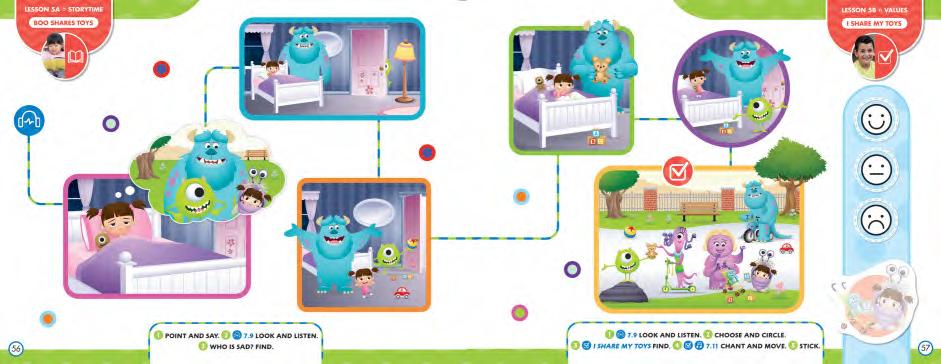
Students can follow the audio path to stay on task and develop fine motor skills
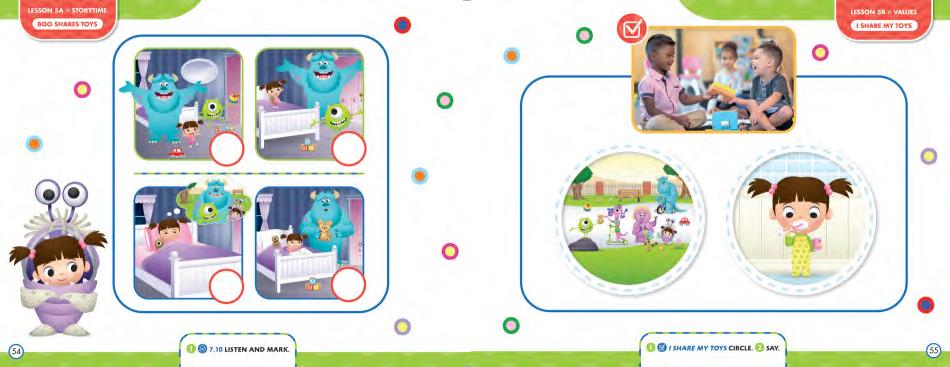
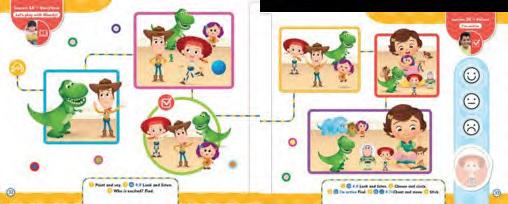
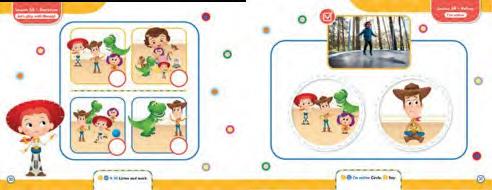
Lesson 5B reviews the story with a focus on a real-world value
The value presented in the story encourages students to monitor their behavior, encouraging both self-awareness and persistence and growth
Students circle to evaluate the story, developing their fine motor skills and self-awareness
Students review new language through a variety of learning modes: audio, a chant, circling, and sticking
The reward sticker helps students stay on task and develops motivation
Students check their comprehension of the story and practice their fine motor skills
Students see the value taught in the story in the context of a real-world photo to consolidate understanding
Students check their comprehension of the value and practice their fine motor skills
10
Workbook
Student’s Book
Lesson 5A • Storytime Lesson 5B • Values
Lesson 6 consolidates the core language and topic of the unit in a real-world setting
Students mark the picture they like, developing self-awareness
Students revisit the unit value, learning that we are all different, but also similar –developing social awareness
Students can follow the audio path to stay on task and develop fine motor skills
Students consolidate new language through a variety of learning modes: audio and mark-making
Students look for an odd one out, developing their critical thinking. Marking helps develop fine motor skills.
Lesson 7 reviews the unit language in fun, creative ways. Students revisit the unit’s video song and do a simple craft activity using press-outs from the back of the Student’s Book, developing fine motor skills
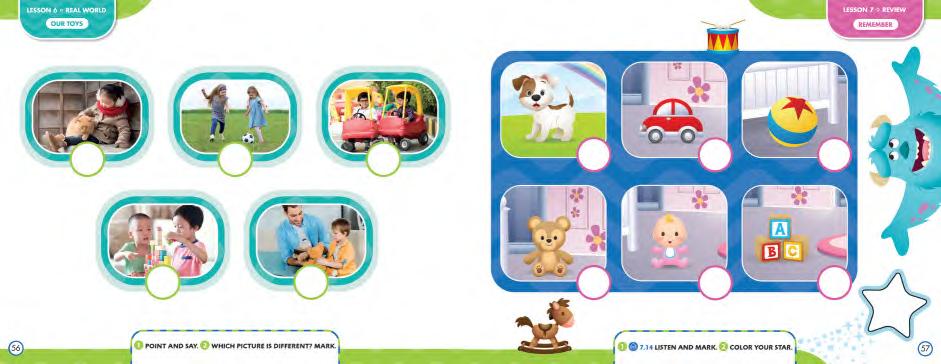


The completed project is used to review the unit language
The reward sticker encourages students to stay on task and develops their motivation

The unit ends with a lesson based on a Disney movie clip, which consolidates the unit language in a different context
The audio activity reviews the core language and tests students’ listening comprehension
Students color the reward star, which develops their motivation
11
Workbook
Student’s Book
Lesson 6 • Real world
Lesson 7 • Review
Student’s Book
The Disney movie lessons at the end of each unit of teaching notes in the Teacher’s Book are optional lessons which provide a rewarding way for students to consolidate their understanding of the unit language and themes.
Students watch a short clip from a Disney movie, and respond to simple comprehension questions and prompts from the teacher.
Phonics • Letters
The Phonics and Letters sections at the back of the Student’s Book and the Workbook are optional lessons providing students with an introduction to sound-letter association

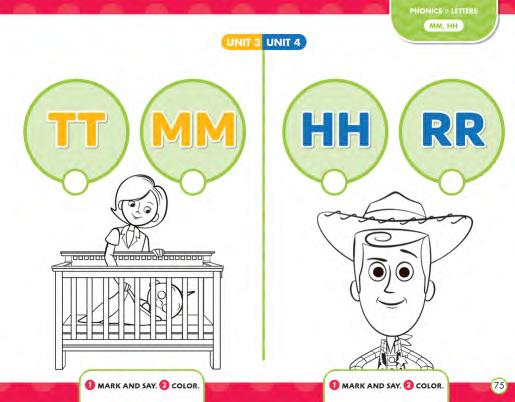
Students learn to recognize shapes of letters and practice motor skills
Students begin to form sound-letter associations
Students practice letter-recognition skills
Students practice picture-sound association skills
Workbook
Disney movie lesson
Teacher’s Book
Frozen Disney movie lesson

12
Time
My Disney Stars and Friends is flexibly designed to suit your specific classroom needs and scheduling requirements. To help you plan, we estimate that teaching materials for the Student’s Book and the related practice in the Workbook may take around 40 minutes of classroom time.
By using the Disney Video lessons, optional Phonics lessons, extra activities in the Teacher’s Book, and digital activities, you can add more practice and consolidation to extend the material.
The actual time it may take you to cover a unit depends on many factors, such as the makeup and needs of your class, as well as how well the students cooperate as a group. You may also have to consider how much time is needed for review or for presentation, and how often features such as songs, stories, or games are revisited.
The teaching notes outline the core activities for each lesson as well as list a range of additional
activities and games that can help consolidate the material.
As the lesson structure is repeated for each type of lesson in the unit, you will soon be able to decide which elements you want to focus on more or omit.
The tables below suggest several options of how best to use the material to tailor it to your particular teaching context.
Additional
13
guidelines
Option 1 (2 lessons a week) Option 2 (3–4
a week) Option 3 (4–5
a week)
lessons
lessons
Components SB core activities WB activities done in the class or at home SB and WB activities + video lessons or phonics lessons SB and WB all activities + video lessons and phonics lessons
There are nine units in each level of the course. We suggest the following approach to cover one unit every four weeks: WeekLessonFocus 1 1 2 Key vocabulary Key structure 2 3 4 Feelings Numbers/Colors/Shapes 3 5A 5B 6 Story Value in the story Real world 4 7 Video Review and Project Unit consolidation Optional PhonicsOptional phonics at the back of the book
Example unit plan
Pathways through the TB Core activities (marked with the icon) in the teaching notes Story lessons 5A and 5B condensed into one All activities in the teaching notes Video lessons or phonics lessons All activities in the teaching notes Video lessons and phonics lessons
Possible pathways through the material
practice can be added by focusing more on the songs, chants, stories, games, digital activities, and the extension/extra activities (marked with the icon) in the teaching notes.
Classroom management
Careful class management is key with very young learners. We have planned the course with this in mind and added features which will make it easier to run successful, engaging, and well-paced lessons. To facilitate the creation of a classroom routine with your students, we have designed the teaching notes in My Disney Stars and Friends so that they always follow the same basic structure for every lesson.
Hello
Greet students, let them settle down, and sing the Hello Toolkit song.
Circle time
You might also refer to this stage as “carpet time” or something similar. It is the stage of the lesson which introduces and focuses students on the topic of the day. This stage might take place when all the students are sitting together at the front of the class, before they sit at their desks for more formal learning or to work from their books, and so is a good opportunity to work on group-communication skills. With the help of the Mickey Mouse puppet, we suggest how you can introduce the new language, or review language from the previous lesson. In the Storytime lessons, we suggest you use Circle time to introduce the story with the Story Cards. Make sure all your students are sitting comfortably, have enough space, and can see you well.
Book
time
Book time uses activities in the Student’s Book and Workbook, including a mix of heads-down and mark-making activities, as well as energetic chants and games.
Goodbye
End each lesson with the Goodbye Toolkit song. If you have the time, you can also sing the Good job Toolkit song beforehand.
Other suggestions for routines
• Use the Sit down Toolkit song after very active games.
• Use the Let’s move Toolkit song if students need an energy boost.
• Use the Let’s clean up Toolkit song when you clean up.
• Use the Good job Toolkit song when you want to celebrate students’ achievement.
• Use the Mickey Mouse puppet, Story Cards, and Picture Cards at the same stages of each lesson.
• Use an established signal such as a bell, rattle, or raising a hand to indicate the end of activity, or to gain students’ attention.
• Establish a routine for when children need to go to the bathroom.
Adding variety to your classes
Children of pre-primary age have a short attention span. It is therefore important to keep a good supply of short activities that go over the same language in different ways, ideally engaging different skills and senses. While a set routine is important, it’s also important to have some ideas for spontaneous activities in reserve, if you notice that your class needs a change of pace or direction.
• Look out for extra activities in the teaching notes.
• Look at the Games bank on page 16 for ideas of additional games to play in the lessons. As students become familiar with the rules, the games will become faster to set up, which will help maintain the pace of your lessons.
• If you can use technology in the classroom, adding interactive activities to the lesson flow from the Pearson English Portal will add another context for the same language.
• Minimize distractions to help students focus on the lesson. Encourage them to keep a clear space around them – they should only have in front of them what they need for the lesson. Ensure students do not sit too close to each other and that they can all see you well.
• Use an agreed little rhyme to attract students’ attention, in which they need to complete the last word – this will help them focus on you.
14
Promote good behavior
Doing this will help your lessons run more smoothly. Rules will be easier to follow if students understand your expectations and see their efforts rewarded.
• Outline your expectations clearly. Consider spending some time discussing them with students and creating some visual reminders together to be displayed and referred to in the classroom.
• Reward students for following the rules. This could be a mark on the board or in their books, such as a star or a circle.
• Use instances of good and bad behavior to review your class rules.
• Help students meet your expectations by following a lesson structure that is clear and varied.
Make students feel comfortable, safe, and valued
Establishing routines and clear expectations will help create a safe setting. Going into class with a positive, encouraging attitude will make a big difference to students’ engagement and progress, which will help them learn better.
• Learn all the students’ names so you can call them out.
• Make sure you address all the students in the class, so no one feels left out.
• Use the Mickey Mouse puppet to create a cozy atmosphere and to model positive behavior.
• Praise students for staying on task, for trying again, and for not giving up on tasks they find difficult.
• Four of the lessons in this course end with a
reward sticker, and it is worth repeating at this stage that the sticker is for working hard and doing a great job.
• Increase students’ sense of pride and ownership of the classroom by displaying their work on the walls.
• Use the feelings vocabulary students learn in this course to help them understand how they feel.
Speak as much English as possible
While using very young learners’ own language can be beneficial in the case of discussing values or stories, it is good to set up the English class as an English-language environment. To facilitate this, the teaching notes include the Teacher Talk feature , where simple, specific phrases replace regular bullet points in the activity procedure. Students will quickly get used to the lessons being guided by fixed routines and will also quickly come to understand familiar and repetitive classroom language in English.
Another reason why it makes sense to speak English in the class is that very young learners may take a little while before they can start speaking a new language, but it is likely they will understand it earlier. Try to create as many opportunities as possible for them to absorb the language, and encourage other ways of interacting with it, for example:
• activities that get children to react or respond to language they hear
• songs and chants
• choral repetition
• listening and repeating as much as possible.
Praise students for their effort. If they don’t quite manage to pronounce a word well, praise them and repeat the word correctly.
15
Games bank
What’s this?
Hold up a Picture Card so the back of the card is facing the students.
Turn the card over and have students guess the word. To make this more fun, you can show it just for a very short time, but make sure you do this long enough for all students to see.
Alternative: Cover part of the picture and have students guess what it is. If they are struggling, you could slowly reveal more until they guess.
Alternative: Cover objects with a cloth so students can guess by the shape.
Picture Card memory games/ What’s missing?
Lay out several Picture Cards and get the class to repeat the words one by one. Turn one over and get students to say the word as if it was still there. Continue with the next card.
Alternative: Lay out several cards and then turn them all face down. Say a word and get students to try and find the right card. As they turn over a card to reveal the picture, repeat the word and get the class to say Yes or No.
Alternative: Cover objects with a cloth, ask students to close their eyes, and secretly remove one object.
Where is ...?
Place several Picture Cards around the classroom. Ask students to find and point to the right card as you say words.
This game can also be played using objects.
Feelings peekaboo
Cover your face with your hands. Make a face to show one of the feelings the students have learned. Take your hands away, and say how you’re feeling. Repeat several times and then encourage students to do the same. When students know the game well, have them guess the feeling instead of telling them.
Picture Card whispers
Put the Picture Cards on the board. Line up the students. Whisper a word to the first student and get them to pass the message to the next student, again using a whisper. The last student needs to point to the correct card.
Mickey says
A version of Simon says but with the Mickey Mouse puppet giving instructions. If he says Mickey Mouse says jump, students need to jump. If he just says Jump, students need to stand still.
Pass a card
Have students sit in a circle.Have students pass a Picture Card around the circle. Say a word from one of the cards and have the student with that card stand up. Repeat with all other words, then give the cards out to different students and repeat until they have all had a turn. This version of the game will work with children who are not yet comfortable with speaking.
Alternative: Have that student sit in a circle. Pass a Picture Card to the student next to you and say the word on the card. Have students do the same. Keep going until the card has gone around the circle. Once students know the activity well, you can have two or even three cards being passed around at the same time. This activity can be used with students who are comfortable saying words.
Alternative: Have students pass Picture Cards in a circle while you play a chant. Stop the music and get the students with cards to say the word for the card they are holding. This activity can be used with children who are comfortable saying words. Hide and seek
Show an item or a Picture Card to students. Have the students close their eyes, then hide the card somewhere in the classroom and have them find it. If they can, have them name the item, and maybe its location (chair, table).
16
Frozen statues
Play a chant and get students to walk in a circle, dance, or jump until you stop the music. When the music stops, students need to stand as still as they can. Praise their efforts and continue.
Alternative: Show students a Picture Card and say the word. Have them mime to show the word or action. When you call Stop, students freeze.
Race
Play this game with three students at a time. Students line up as if for the start of a race. Lay several objects from the vocabulary group you are working on in front of each student, about a meter apart. Call out the objects that students have to pick up and run with to the finish line.
Treasure hunt
Have students find as many objects as they can in the class or on a walk. This game works well with colors and school objects, but also with toys or play food items scattered around the classroom.
Shopping
Create a store in the classroom. Use Picture Cards, play food, or toys. Have students ask for items and practise vocabulary, such as please and thank you. To start with, you may want to play the role of the storekeeper yourself.
Find a partner
Make sure you have at least two of each object or picture. Give them to students. Have them walk around the class saying I have a ... until they find other students with the same object.
Hide and count
Place some items on a table, for example, books, toys or play food. Have students close their eyes, hide several books around the classroom and have students find and count them.
What am I drawing?
Draw a picture slowly on the board and have students guess what it is.
Jump/dance/walk to a number
Put Picture Cards with numbers students know around the classroom. When you say Jump/ dance/walk to three, students have to jump, dance, or walk to the correct card. Repeat with other numbers.
Jump/dance/walk to a color
Put Picture Cards with colors students know around the classroom. Tell them to walk, jump, or dance to a color.
Extend this by playing the lesson’s color chant while students are making their way to the right color.
17
Course features
Puppet
Puppets provide an element of engagement, and they can help you model language and behavior for students. My Disney Stars and Friends has its own Mickey Mouse glove-puppet. The Circle time teaching notes for each lesson use the Mickey Mouse puppet as the presenter of the lesson and include specific instructions on how to interact with it to engage students, although you may wish to introduce each lesson in your own way. If necessary, the Circle time procedures could be played out with any puppet or toy of your choosing. Here are some more suggestions for how to use the puppet during the lesson:
• Make the puppet part of the class experience. Invite him to listen to a story, join in with a game, or song, and get him to have fun with the class.
• Make the puppet greet every child at the start of the lesson. This will help make students feel welcome and will encourage them to say hello.
• Model new language. You can have short conversations with him to ask questions and give answers.
• Review language at the start of the class. He can help you ask questions.
• Model good behavior. In the conversations you have with him, treat each other very kindly.
• Praise and encourage students.
• Say goodbye to students, yet again making sure he addresses them all using their names.
Picture Cards
Ideas for using the Picture Cards are integral to the lesson notes. However, you can also use them in the following way to introduce new vocabulary:
• Show Picture Cards to students, one by one, and repeat the word.
• Make the puppet repeat the word, too.
• Have students repeat the word chorally.
• Following that, use the games suggested in the Games bank on page 16 to practice and review the vocabulary.
Story Cards
The Story Cards have been designed for ease of use, with a full-size single frame of the story on the student-facing side of the card, and a thumbnail image, audio script, and key prompts and questions on the reverse, giving teachers everything they need to get the most out of the stories.
Ideally, the Story Cards would be presented in Circle time of the story-based lessons (5A and 5B), when students are sitting comfortably and can see both you and the cards well. If the setting of your class does not allow for this, you can use the cards while students are at their desks.
• Show the Story Cards to students one by one and encourage them to look for words they know. Accept all ideas and praise students.
• Read the story or play the audio while showing the cards to students one by one. Point to characters or objects as they are mentioned.
• Review the cards again, asking the questions provided on the reverse of the card.
• Let students listen to the story as many times as they want (time allowing). If they want to join in, make sure you praise this effort.
• Use the Story Cards as a prompt while acting out the story. Put the card or cards that represent the part of the story students will act out on the board so everyone can see them.
• Use the Story Cards to review the story any time students want to hear it again for enjoyment.
Posters
Feelings
Use the Feelings poster in Lesson 3 of each unit to get students to identify the new feeling for the unit, but also to review the ones already learned. You can also use the Feelings poster as part of your class routine to ask students how they feel.
Values
Use the Values poster in Lesson 5B of each unit to get students to identify the new value for the unit. You can also use the poster as a reference to all the values they have learned so far, especially to remind students of the values they may want to apply while working together.
Colors and Numbers
Use the Colors and Numbers posters in Lesson 4 of each unit to get students to identify the new number or color. You can also use the posters as reference and to consolidate all the vocabulary from these groups.
Weather
Use this poster as reference when you talk about the weather in your classroom routine.
18
Video
There are two types of videos in the course:
Action song videos
Action song videos cover the key language of the unit, both the vocabulary and the structures. They are introduced in Lesson 2 and returned to in Lesson 7. You can also use these videos as a lesson warmer, cooler, or filler, especially if you want to energize students, or make good use of already high energy levels in the class. We suggest the following procedure for these:
• Play the video and join in with the actions.
• Play the video again. Students join in with the actions and words if they can.
Disney videos
The final page of each unit of teaching notes provides a full lesson based on a Disney movie clip. The Disney videos consolidate the unit language and/or themes in a new but familiar context, providing a fun and rewarding ending to the unit. We suggest the following procedure for these videos:
• Let the students watch the entire clip.
• Watch again, this time stopping to ask questions relating to unit language.
• Let students watch the whole clip once more, to enjoy it with a better understanding.
• Hand out drawing paper and crayons. Let students draw anything they wish from the clip.
Stickers
The course provides several reward stickers to be awarded at the end of particular lessons. This is a good opportunity to congratulate students for their work in the class and for their effort on the activities. We suggest the following procedure for the sticker activities:
• Help students find the right sticker. Make sure everyone has selected the right sticker before they peel it off.
• Ask students to peel off the sticker. Check again that this is the correct one.
• Ask students to find the correct page for the sticker. Make sure they are pointing to the right place on the page.
• Have students stick the sticker on the page.
• Remember to praise students.
One exception to this routine is the sticker in Lesson 1, which students can place anywhere on the page to personalize the scene in a way that is pleasing to them.
Audio
The audio in My Disney Stars and Friends is available in both American English and British English.
Toolkit songs and chants
My Disney Stars and Friends features a set of “Toolkit” songs which may be helpful in structuring the lesson and helping students move from one stage or mood to another. They are for you to use whenever you feel appropriate, so we have not always listed them in the teaching notes. If you use them regularly, students will quickly learn to recognize them and their melodies will be a clear indication of the next lesson stage. The Toolkit song lyrics are not displayed in the lesson notes, but are listed in a single place of reference on page 20.
0.1 Hello song
If possible, play the song at the start of every lesson to mark its beginning. Create a procedure around it, which could include greeting all students by their name and students greeting you.
0.2 Goodbye song
The Goodbye song is designed to mark the end of the class. Make sure students clean up their desks before you sing it. You may want to say goodbye to each student individually as they leave the room.
0.3 Sit down song
This song will help students calm down after an exciting game. It is designed to settle them, so that they are ready to focus again.
0.4 Let’s move song
This song is designed to help you change the mood of the class if you feel they need to do something energetic, for example, after a craft activity or a longer heads-down task. It is a highenergy song with a fast pace, so you should encourage your students to move to the music, as the song title suggests.
0.5 Let’s clean up song
This is a song to play when you need students to clean up after an activity. It is good practice to encourage students to keep their desks clean, both to instill good habits and to minimize distractions for the rest of the class.
0.6 Good job song
This song is designed to let the class celebrate their effort and achievement. Praise students for their work. Then play the song and have the class join in and enjoy their success.
19
Toolkit song lyrics
Refer back to this page from the teaching notes when you want to review the lyrics for the Toolkit songs. As the course progresses, you and your students will probably commit them to memory!
0.1 Toolkit song 1: Hello
Hello, hello, Hello, hello, hello! Hello! How are you?
Hello, hello, Hello, hello, hello! I’m fine, thank you!
0.2 Toolkit song 2: Goodbye
Goodbye, goodbye, Goodbye, my friends. Goodbye, goodbye! See you soon! See you soon! Goodbye! Goodbye!
0.3 Toolkit song 3: Sit down
Good, good, very, very good! Sit down, sit down! Good, good, very, very good! Sit down, sit down! Sit down ... Sit down ... Sit down ... Very good!
0.4 Toolkit song 4: Let’s move!
Let’s move, let’s move!
Stretch!
Stretch, stretch, stretch!
Let’s move, let’s move!
Shake!
Shake, shake, shake! Stretch!
Stretch, stretch, stretch! Shake!
Shake, shake, shake!
Let’s move! Let’s move! Yay!
0.5 Toolkit song 5: Let’s clean up!
Uh oh, uh oh!
Look at the classroom, uh oh!
Let’s clean up, let’s clean up, Let’s clean up ...
Now!
0.6 Toolkit song 6: Good job!
Good Job! Good Job! Wow! Wow! Wow! Let’s clap for you! Now take a bow!
Course icon guide
My Disney Stars and Friends uses the following icons to help you navigate the course more easily.
0.0 spoken audio track
0.0 song/chant audio track game video value-based activity
Student’s Book and Workbook icons Teacher’s Book icons
fast-track activity
Teacher Talk wording teaching tip extra activity Future Skills information
Disney movie lesson signpost
20
Unit Overview

Objectives


























































































































Speaking









• Can recite a short, simple rhyme or chant.





• Can use a few basic words to say how they feel, if supported by pictures.



























































• Can use a few basic words and phrases to talk about a familiar topic.


Listening








• Can understand basic fixed expressions for greeting and leave-taking (e.g., "Hello," "Goodbye").

• Can recognize a few basic words and phrases about a familiar topic.


Phonics and letters






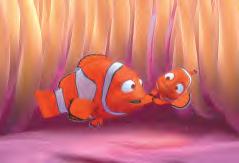

• Gg; goodbye




























Snow White is beautiful because she is good, kind, and never negative.
very friendly


Happy and he likes
Bashful is very shy. He giggles a lot and he sometimes hides behind his beard.




Sneezy is always sneezing. Sometimes, he can’t speak because he needs to sneeze.
Grumpy likes to complain about everything and he can be very rude.
Doc is very smart, but he sometimes forgets where he is or he gets confused when he is speaking.
Sleepy is always tired. He just wants to sleep all the time.
4 1 1.3 LISTEN LISTEN AND SAY. HELLO! GOODBYE! CHANT AND MOVE. 3 STICK. 4 MARCHING PLAY. HELLO! 1 HELLO, GOODBYE LESSON 1 • VOCABULARY M01 Little Friends and Heroes SB1 GLB 95524.indd 4 4/4/22 4:40 PM Finding Nemo Disney movie lesson
hello, goodbye, I’m happy, green, I’m friendly Grammar I’m (Danny)
Vocabulary
Key GSE Learning
Hello! 1
Dopey is the youngest dwarf, so he doesn’t have a beard yet. 21
























































































































4 1 1.3 LISTEN AND SAY. 2 1.4 HELLO! GOODBYE! SING AND MOVE. 1 1.1 LISTEN AND SAY. 2 1.2 HELLO! GOODBYE! CHANT AND MOVE. 3 STICK. 4 MARCHING PLAY. HELLO! 1 HELLO, GOODBYE LESSON 1 • VOCABULARY M01 Little Friends and Heroes SB1 GLB 95524.indd 4/4/22 4:40 PM 2 HELLO! 1 1 DRAW AND COLOR. 2 SAY. 1 MATCH AND SAY. HELLO, GOODBYE LESSON 1 • VOCABULARY M01 LLittle Stars and Friends WB1 GLB 95494.indd 2 4/4/22 10:52 AM Lesson 1 • Vocabulary hello, goodbye Lesson aims • to introduce the main unit characters • to introduce hello and goodbye in context Target language • hello, goodbye Main GSE Learning Objective • Can use basic informal expressions for greeting and leave-taking (e.g., "hello," "hi," "bye"). Future Skills • Social awareness • Persistence and growth Materials • Unit 1 Picture Cards (hello, goodbye) • Sticker (bird) • Mickey Mouse puppet Student’s Book Workbook 1.1
1.2 Hello!
22
Hello! Hello! Goodbye! Goodbye!
Goodbye! Hello, hello, hello! Hello, hello, hello! Goodbye, goodbye, goodbye! Goodbye, goodbye, goodbye!
Hello Book time
0.1 Greet students and sing the Hello song.
Look at each student and greet them by name.
Look at the Teacher Talk icons and see page 15 for ideas on how to create an Englishlanguage environment in your classroom.
Circle time
Circle time encourages good group communication. Arrange chairs or mats so that you can all see each other. Allocate a space for each child.
• Choose a pretend home for the Mickey Mouse puppet, e.g., a bag or a box. Make him come out of his home to see you and the students. Hello, Mickey!
• Make Mickey say Hello, (your name).
• Then make him say Hello to each student.
• Have students say Hello to Mickey.
• Show the Unit 1 Picture Cards and make Mickey look enthusiastic.
Look, Mickey. Snow White says “Hello!” Bashful says “Goodbye!”
• Say Hello! and make Mickey point to the correct card and say Hello! Have students join in. Repeat several times with both Hello and Goodbye. Make Mickey hesitate as if he’s finding it difficult and encourage students to help him.
Make sure each student has found the correct page.
Student’s Book p4
• Have students open their Student’s Books. Point to each of the characters in turn and ask Who’s this? Elicit their names if possible, then say Hello to each character and encourage students to do the same.
1 1.1 Listen and say.
• Play the audio. When it says Hello! open the Student's Book and wave at the characters. When it says Goodbye!, wave at the characters and close the book.
• Play the audio again. Have students point to the characters on the page and say Hello and Goodbye.
2 1.2 Hello! Goodbye! Chant and move.
• Play the chant and mime. Wave Hello with one hand and Goodbye with the other. Step back when you say Goodbye.
• Play the chant again. Have students join in with actions and say the words if they can.
Social awareness: Knowing how to greet people appropriately is an essential relationship-building skill in any language.
3 Stick.
• Have students find the sticker of the bird.
Show students how to press the paper and unpeel the sticker.
• Students can stick this anywhere on the page.
Persistence and growth: As students begin to associate task completion with the reward of getting a sticker, they will be motivated to maintain and repeat their efforts in subsequent lessons and units of the course.
4 Marching Play.
• Have students stand up in a row or line.
• Play the Hello! Goodbye! chant again. [1.2]
• When students hear or chant Hello, they march towards you. When they hear or chant Goodbye, they march back again.
• Have them wave Hello and Goodbye as they march and chant.
Walk in and out of a real or pretend door to demonstrate greeting and leave taking.
Workbook p2
Make sure each student has a pencil or a crayon.
1 Match and say.
• Point to Snow White on the left, wave, and say Hello! Point to the silhouette of Snow White on the right and say Hello? Hello? (Yes)
• Show students how to trace the line between the two pictures.
• Repeat for Bashful and Goodbye.
• Have students point to the pictures and say Hello and Goodbye.
Goodbye
0.2 Sing the Goodbye song.
Make the Goodbye song part of your routine.
23
1.3









A: Hello. I’m Danny.


B: Hello. I’m Ella.
1.4 Hello! Goodbye! Hello, I’m Ella. Hello! Hello! Hello, I’m Danny. Hello! Hello! Hello, hello, hello! Hello, hello, hello!
Goodbye, Ella! Goodbye! Goodbye! Goodbye, Danny! Goodbye! Goodbye! Goodbye, goodbye, goodbye! Goodbye, goodbye, goodbye!
Hello. I'm ... Hello, Hello. Hello, I'm ... Hello! Hello! Hello, hello, hello! Hello, hello, hello! Goodbye, ... Goodbye! Goodbye! Goodbye, ... Goodbye! Goodbye! Goodbye, Goodbye, Goodbye! Goodbye, Goodbye, Goodbye!
















5 1 1.3 LISTEN AND SAY. 2 1.4 HELLO! GOODBYE! SING AND MOVE. 3 HELLO, I’M ... PLAY. LISTEN AND SAY. 2 1.2 HELLO! GOODBYE! CHANT AND MOVE. 3 STICK. 4 MARCHING PLAY. LESSON 2 • GRAMMAR I’M DANNY M01 Little Friends and Heroes SB1 GLB 95524.indd 5 4/4/22 4:40 PM 3 1 DRAW AND COLOR. 2 SAY. 1 MATCH AND SAY. I’M DANNY LESSON 2 • GRAMMAR M01 LLittle Stars and Friends WB1 GLB 95494.indd 3 4/4/22 10:52 AM Lesson 2 • Grammar I'm Danny Student’s Book Workbook
Lesson aims • to introduce the grammar structure I'm … Target language • I’m (Danny) Recycled language • hello, goodbye Main GSE Learning Objective • Can recite a short, simple rhyme or chant. Future Skills • Social awareness Materials • Unit 1 Picture Cards (hello, goodbye) • Mickey Mouse puppet [Student’s own drawing] 24
Hello Circle time
0.1 Greet students and sing the Hello song.
Point to a student and say Hello (student's name). Have all the other students in the class repeat this. Then do the same for each of the other students in the class.
point to the pictures in their Student’s Books, repeating what they hear.
2 1.4
Hello! Goodbye! Sing and move.
If you can’t play the video in class, play the audio version of the song instead and add appropriate actions (Wave when you hear Hello and Goodbye. Point to yourself when you hear I'm ... .) If possible, try to watch the video before the class to get some ideas for actions.
• Play the video and join in with the actions on the screen.
1 Draw and color.
• Draw a simple head and shoulders sketch of yourself on the board.
• Point to the picture on the board.
Hello! I’m (your name).
• Students complete the outline in their Workbooks with their own eyes, nose, mouth, and hair. They can add things they wear (e.g., glasses), too.
• Encourage them to position their features correctly, e.g., eyes above the nose and mouth beneath the nose.
• Make Mickey come out of his home and greet you and the students.
• Show Mickey and the students the Picture Cards to review the vocabulary.
• Point to yourself. I’m (your name).
• Make Mickey say I’m Mickey! Say Hello, Mickey! Then have Mickey reply Hello, (your name).
• Make Mickey turn to the students and say I’m Mickey! Have a student greet Mickey in the same way. Repeat with as many students as are happy to talk to Mickey in this way.
• Play the video again. Students join in doing the actions and singing the song if they can.
• Sing the song again and add your own name where there is a gap after Hello, I'm ... . Look at a student and say the student's name where there is a gap after Goodbye ... .
Let students join in speaking and singing when they are ready. At this very early stage in their education, they may not all be ready to do this from their first few English lessons.
Social awareness: Knowing how to introduce yourself is an essential relationshipbuilding skill in any language, and helps build self-confidence.
3 Hello, I’m … Play.
Book time
Student’s Book p5
1
1.3 Listen and say.
• Play the audio. Point to each child in the picture as they speak.
• Play the audio again and have students
• Say a child’s name, e.g., Anna. (Anna) stands up and says I’m (Anna)!
• Repeat with other students.
Workbook p3
If you wish students to do the Workbook for homework, date the activity page and inform parents/carers.
• Let students decide what colors they want to use when they draw their faces and hair.
• Then have students color their picture.
2 Say.
• Have students point to their picture and say I’m (Marcos).
Goodbye
0.2 Sing the Goodbye song.
• You can now do the Unit 1 Phonics lesson (see Student’s Book page 76 and Teacher’s Book page 183).
25
1.5






























Picture 1: I’m happy! Whee!


































Picture 2: I’m happy!
Picture 3: I’m happy!

Picture 4: A: Look! B: I’m happy! 1.6 I’m happy I’m happy! I’m happy! I’m happy today!






























































































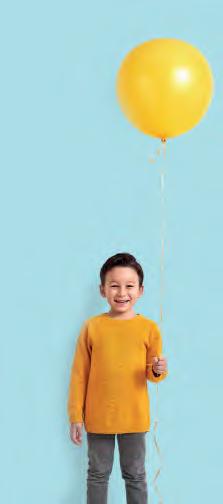
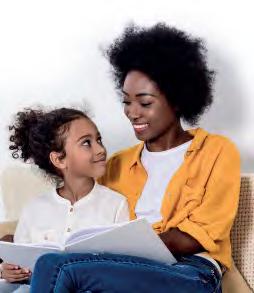
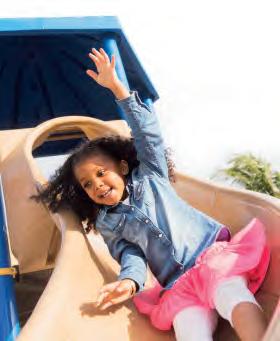
I’m happy! I’m happy! I’m happy today!

26 6 1 1.5 LISTEN. 2 1.6 I’M HAPPY SING AND MOVE. 3 STICK. 1 1.7 LISTEN AND SAY. 2 1.8 COLORS CHANT AND MOVE. 3 COLOR. 4 LESSON 3 • FEELINGS I’M HAPPY M01 Little Friends and Heroes SB1 GLB 95524.indd 4/4/22 4:40 PM 4 LESSON 3 • FEELINGS I’M HAPPY 1 MATCH AND COLOR. 2 SAY. 1 WHO IS HAPPY? CIRCLE. 2 SAY. M01 LLittle Stars and Friends WB1 GLB 95494.indd 4/4/22 10:53 AM Lesson 3 • Feelings I’m happy Lesson aim • to introduce the word happy and recognize, understand, and express the feeling of happiness Target language • I’m happy Recycled language • I’m (Danny) Main GSE Learning Objective • Can use a few basic words to say how they feel, if supported by pictures. Future Skills • Self-awareness • Persistence and growth • Social awareness Materials • Sticker (Happy the dwarf) • Mickey Mouse puppet • Feelings poster Student’s Book Workbook
Hello
0.1 Greet students and sing the Hello song.
Circle time
Self awareness: Happiness is often displayed by smiling widely, but it is also often expressed through body language. When we feel happy, we often move our bodies freely. A feeling of happiness doesn’t have to be excitement or joy. It can also be a gentle contentment, which is no less strong but can be harder for young children to recognize.
Use expressive mime to indicate happiness.
• Mime a big smile as you say Happy Make Mickey say Yes! I’m happy!
Make him move up and down, and open his arms out wide and say My friends! I’m happy!
• Make Mickey greet each student by name and have them greet him. Make him look happy each time.
• Turn to students and say Mickey is happy!
• Then point to your smile and say I’m happy! Have students repeat after you.
• Frown or look sad, and ask Mickey Happy? Make Mickey say No
• Repeat, miming happy and unhappy faces. If you look happy, students smile and say I’m happy! If not, they say No!
• Invite students to mime feeling happy or unhappy for the others to guess.
Book time
Student’s Book p6
• Look at the pictures together. Point to each person or item as you mention them.
Look at the girl. She’s on a slide! She’s happy.
Look at the girl. She’s with her daddy. She’s happy.
Look at the boy. He has a balloon! A yellow balloon! He’s happy.
Look at the girl. She’s with her mommy. Look, a book. She’s happy.
1 1.5 Listen.
• Play the audio and point to the pictures.
• Play the audio again. Have students join in, saying I’m happy.
Mime going down a slide or holding a balloon, or use the real objects if they are available.
2 1.6 I’m happy Sing and move.
• Play the song and mime being happy.
• Play the song again. Have students sing the song and mime being happy.
3 Stick.
The sticker shows Happy the dwarf.
• Have students find the Happy sticker.
Is he happy? (Yes)
• Help students find the correct place on the page to stick their sticker.
Persistence and growth
Feelings poster
• Help students identify the happy face on the Feelings poster.
• Congratulate them for completing this observation activity.
0.6 Play the Good Job song to encourage students to feel proud of their achievement. Sing along with the song and mime the actions.
Workbook p4
1 Who is happy? Circle.
• Look at the pictures together and have students decide who looks happy.
• Have them trace circles around the happy pictures with their fingers, then with a pencil.
Students might decide that the picture on the bottom left also shows a happy child. As we all show feelings in different ways, you should acknowledge their opinion.
Social awareness: Non-verbal cues are very important to successful communication. Learning to recognize others' feelings helps students to communicate appropriately.
2 Say.
• Have students point to the happy pictures and say I’m happy!
Goodbye
0.2 Sing the Goodbye song.
27
Colors, colors, lots of colors! Let’s all play the colors game! Green, green, green, green, Jump to green! Jump to green! Green, green, green, green, Jump and dance to green! Green!



































































































7 1 1.5 LISTEN. 2 1.6 I’M HAPPY SING AND MOVE. 3 STICK. 1 1.7 LISTEN AND SAY. 2 1.8 COLORS CHANT AND MOVE. 3 COLOR. 4 COLOR JUMP PLAY. LESSON 4 • COLORS GREEN 2 3 1 M01 Little Friends and Heroes SB1 GLB 95524.indd 7 4/4/22 4:40 PM 5 LESSON 4 • COLORS GREEN 1 MATCH AND COLOR. 2 SAY. 1 WHO IS HAPPY? CIRCLE. 2 SAY. M01 LLittle Stars and Friends WB1 GLB 95494.indd 5 4/4/22 10:53 AM Lesson 4 • Colors Green Lesson aim • to recognize and name the color green Target language • green Main GSE Learning Objective • Can recite a short, simple rhyme or chant. Future Skills • Persistence and growth Materials • Color Cards • Mickey Mouse puppet • green crayons, paints, or scraps of paper Extra resources • green classroom items, e.g., blocks, balls, crayons • classroom items of other colors Student’s Book Workbook
Colors
28
1.7 Green! Green! Green! Green! 1.8
Book time Hello
0.1 Greet students and sing the Hello song.
The target language is green. You could teach the names of the items (frog, turtle, bird, grapes) as extra vocabulary if you wish.
Student’s Book p7
1 1.7 Listen and say.
Circle time
Introduce the words Yes and No in a way students will understand (e.g., by nodding or shaking your head).
• Make Mickey come out of his home and greet you and the students.
• Show Mickey and the students the green Color Card.
Look, Mickey. It’s green. Green!
• Make Mickey say Green! Yes, Mickey! Good. Green!
• Put some green classroom items in the middle of the circle, along with items of other colors.
Can you find the green things, Mickey? The green things?
• Make Mickey select the green items and say Green each time. You could make Mickey hesitate as if he’s finding it difficult and encourage students to help him.
• Make Mickey say Green! and invite a student to come and select a green item. Good job, everyone! Very good! Green!
• Play the audio. Point to the different items on the page each time you hear the word Green.
• Play the audio again and have students point to the pictures in their Student’s Book and say Green.
2 1.8 Colors Chant and move.
• Place the green Color Card somewhere in the classroom.
• Play the chant and have students jump or dance to the Color Card.
• Play the chant again. Have students join in with the actions and the words.
3 Color.
• Help each student choose a green crayon.
• Students color the grapes green.
Have students find the Disney character (Dopey) and ask Is his hat green? (No)
4 Color jump Play.
• Play the chant again. [1.8] This time, students jump or dance towards anything that’s green (e.g., the door, a table, a display board, etc.), not necessarily to the Color Card.
Have students make green pictures with crayons, scraps of paper, or paints.
Have students look out of the window and point to any green things they can see.
Race (see page 17). Put several classroom objects in front of students, only one of which is green. Call out the word Green! and have students race to pick up the green item. Repeat with different green objects.
Persistence and growth: Focusing on one color for a whole lesson helps students maintain effort, attention, and motivation, and master basic concepts which form the foundation of their learning.
Workbook p5
1 Match and color.
• Look at the pictures together and have students match the pictures on the left with the outlines on the right.
• First, have them trace matching lines with their fingers.
• Then have them draw matching lines between the pairs, using a pencil.
• Finally, have them color in the outlines using green crayons or pencils.
2 Say.
• Have students point to each colored outline and say Green!
Goodbye
0.2 Sing the Goodbye song.
29
Let’s be friends!
Lesson aim

• to understand the target language in the context of a story
Recycled language
• hello, goodbye, I’m (Danny), I’m happy, green




Main GSE Learning Objective

















• Can understand a few basic words and fixed expressions in a story that is read aloud to them, if supported by pictures.
Future Skills
• Social awareness
• Persistence and growth
Materials







• Story Cards
• Mickey Mouse puppet

1.9 Let's be friends!
1: Look! This is Snow White.














2: ”Hello! I’m Snow White,“ says Snow White. ”What’s your name?“

“I’m Sleepy,” says Sleepy. “I’m Doc,” says Doc.
3: Look at Bashful!

“Hello,” says Snow White. “Hello, Bashful!” “Goodbye,” says Bashful!
4: “Look!“ says Snow White. “Oh!” say the dwarfs. “Oh!”


5: Green grapes! Dopey is happy!



6: “Mmm, thank you, Snow White,” say the dwarfs! “Thank you!”
Goodbye, Snow White. Goodbye, dwarfs! Goodbye!
1.10











































Look! This is Snow White!
“Mmm, thank you, Snow White,” say the dwarfs! ”Thank you!”
8 1 1.9 LOOK AND LISTEN. 2 CHOOSE AND CIRCLE. 3 I’M FRIENDLY FIND. 4 1.11 CHANT AND MOVE. 5 STICK. 1 POINT AND SAY. 2 1.9 LOOK AND LISTEN. 3 WHO IS HAPPY? FIND. LESSON 5A • STORYTIME LET’S BE FRIENDS! M01 Little Friends and Heroes SB1 GLB 95524.indd 4/4/22 4:40 PM 6 1 1.10 LISTEN AND MARK. LET’S BE FRIENDS! LESSON 5A • STORYTIME M01 LLittle Stars and Friends WB1 GLB 95494.indd 4/4/22 10:53 AM 9 1 1.9 LOOK AND LISTEN. 2 CHOOSE AND CIRCLE. 3 I’M FRIENDLY FIND. 4 1.11 CHANT AND MOVE. 5 STICK. 1 POINT AND SAY. 2 1.9 LOOK AND LISTEN. 3 WHO IS HAPPY? FIND. LESSON 5B • VALUES I’M FRIENDLY M01 Little Friends and Heroes SB1 GLB 95524.indd 4/4/22 4:40 PM Lesson 5A • Storytime
Student’s Book Workbook
30
Book time Hello
0.1 Greet students and sing the Hello song.
Circle time
Story synopsis
Snow White says hello to the dwarfs. They introduce themselves. Bashful is going the wrong way and he says goodbye instead of hello! Snow White wants to be friendly, so she offers the dwarfs some grapes. Dopey likes the grapes! Snow White and the dwarfs have a nice picnic together.
Make sure everyone can see the Story Cards.
1.9
• Make Mickey come out of his home and greet you and the students.
Mickey, sit down. It’s storytime.
• Make Mickey look excited and make him sit down. Praise Mickey, then show him the Story Cards.
It’s storytime!
• Read the story to students or play the audio without pausing. Show them each Story Card in turn and point to objects and characters as they are mentioned.
• Read or play the story again. Ask some of the key questions on the Story Cards.
Let students listen to the story as many times as they like.
Student’s Book pp8–9
1 Point and say.
• Have students open their Student’s Books and look at the story again.
Look. Can you see something green?
• Students point to the grapes, Dopey’s mouth, the salad, the grass, or the leaves on the trees and say Green.
2 1.9 Look and listen.
Students hear the story twice while looking at the Story Cards. This activity helps them get used to “reading” a story in a book.
• Play the story again. Have students follow the listening path with their fingers and look at the correct pictures as they listen.
Persistence and growth: Reading the story multiple times in a lesson will help students develop their attention spans and early-reading skills. The stories in My Disney Stars and Friends help students develop confidence and motivation to learn by recycling target language from each unit in context.
3 Who is happy? Find.
• Look at the story together.
Who is happy?
• Have students point to the happy characters.
All the characters look happy, except Sleepy. But if students want to say that Sleepy is happy, because he is sleeping, that's OK.
Social awareness: Identifying and understanding others' emotions is an important communication skill. Students review non-verbal cues by identifying the emotions of characters.
Act out a frame from the story. Mime the actions and say the words together. You could recreate scenes using your own classroom items.
Workbook p6
1 1.10 Listen and mark.
• Point to the top two pictures and say Listen.
• Play the audio.
• Point to the pictures again and ask Which picture? Students point to the correct picture.
• Show them how to indicate the correct answer by marking the circle by that picture, then have them mark the picture.
• Repeat with the other two pictures.
This will probably be the first time students have done a listening comprehension activity. As the course progresses, they will become familiar with the concept and the procedure. Students can mark the circle by coloring, scribbling, or drawing a check or cross.
Goodbye
0.2 Sing the Goodbye song.
31
Lesson aims
• to review the story
• to evaluate the story and give a personal response to it
• to recognize and understand the value I’m friendly
• I’m friendly Recycled language


























































• hello, goodbye, I’m happy, green



• Can use a few basic words and phrases to talk about a familiar topic.

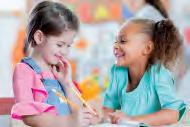
Future Skills
• Social awareness
• Self-awareness
• Persistence and growth Materials










































• Story Cards
• Sticker (Snow White)
• Mickey Mouse puppet
• Values poster Extra
• play food
1.9 Let's be friends!
1: Look! This is Snow White.




2: “Hello! I’m Snow White,” says Snow White. “What’s your name?”
“I’m Sleepy,” says Sleepy.
“I’m Doc,” says Doc.
3: Look at Bashful!

“Hello,” says Snow White. “Hello, Bashful!” “Goodbye,” says Bashful!
4: “Look!” says Snow White. “Oh!” say the dwarfs. “Oh!”


5: Green grapes! Dopey is happy!

6: “Mmm, thank you, Snow White,” say the dwarfs! “Thank you!”
Goodbye, Snow White. Goodbye dwarfs! Goodbye!
1.11































I’m friendly! I’m friendly! I am friendly!
I’m friendly! I’m friendly! I am friendly!
I’m friendly! I’m friendly! I am friendly!

7 1 1.10 LISTEN AND MARK. 1 I’M FRIENDLY CIRCLE. 2 SAY. LESSON 5B • VALUES I’M FRIENDLY M01 LLittle Stars and Friends WB1 GLB 95494.indd 7 4/4/22 10:53 AM 8 1 1.9 LOOK AND LISTEN. 2 CHOOSE AND CIRCLE. 3 I’M FRIENDLY FIND. 4 1.11 CHANT AND MOVE. 5 STICK. 1 POINT AND SAY. 2 1.9 LOOK AND LISTEN. 3 WHO IS HAPPY? FIND. LESSON 5A • STORYTIME LET’S BE FRIENDS! M01 Little Friends and Heroes SB1 GLB 95524.indd 4/4/22 4:40 PM 9 1 1.9 LOOK AND LISTEN. 2 CHOOSE AND CIRCLE. 3 I’M FRIENDLY FIND. 4 1.11 CHANT AND MOVE. 5 STICK. 1 POINT AND SAY. 2 1.9 LOOK AND LISTEN. 3 WHO IS HAPPY? FIND. LESSON 5B • VALUES I’M FRIENDLY M01 Little Friends and Heroes SB1 GLB 95524.indd 4/4/22 4:40 PM Lesson 5B • Values I’m
Workbook
friendly Student’s Book
Target language
Main GSE Learning Objective
resources
32
Hello
0.1 Greet students and sing the Hello song.
Circle time
Social awareness: Friendliness is an important value to promote in young children as it will assist them in becoming approachable individuals and forming good friendships throughout their lives.
• Make Mickey come out of his home but NOT greet you and the students.
Hello, Mickey!
• Make Mickey respond in a way that isn't friendly. Look sad.
• Repeat, but this time make Mickey say Hello, (your name)! Look happy when he is friendly to you.
Good, Mickey! You’re friendly!
• Make him say Yes! I’m friendly! Have students repeat with him.
• Show the first Story Card to students. Can you remember who is friendly? Let’s listen to the story again.
1.9
• Read or play the story again. Pause the audio after each frame and ask students the key questions on the Story Cards to check their understanding.
Book time
Student’s Book pp8–9
1 1.9 Look and listen.
• Play the story again. Help students follow the story in their Student's Books by pointing to the correct picture.
2 Choose and circle.
• This is an evaluation activity where students express their opinion of the story.
• Point to the happy, neutral, and sad face icons on the blue panel, one by one.
I like this story (look happy). It’s OK (look neutral). I don’t like this story (look unhappy).
• Show students how to think, choose, and then circle one icon. Use expressive mime to demonstrate thinking and deciding.
• Students decide which of the three icons reflects their opinion and circle that icon.
Students may not fully understand this evaluation process now. That’s OK. As the course develops, they will start to make their own judgments.
Self-awareness: The story evaluation feature in this lesson gives students the opportunity to reflect on and express how they feel about each story.
3 I’m friendly Find.
• Point to Snow White waving and say She’s friendly!
• Then point to Snow White with the grapes. This time students repeat She’s friendly!
• Have students point to the other pictures and say He's/She's friendly!
4 1.11 Chant and move.
• Play the chant and mime being friendly.
• Play the chant again. Have students join in with the actions and words.
5 Stick.
The sticker shows Snow White being friendly by holding grapes for the dwarfs.
• Have students find the I’m friendly sticker.
• Help students find the correct place on the page to stick their sticker.
Persistence and growth Values poster
• Help students identify the characters being friendly on the Values poster.
Workbook p7
1 I’m friendly Circle.
• Look at the pictures together and have students identify the friendly picture at the bottom.
• Have them trace the circle around the picture with their finger, then with a pencil.
2 Say.
• Have students point to the correct pictures and say I’m friendly.
Goodbye
0.2 Sing the Goodbye song.
33
Lesson aim
• hello, goodbye, I’m friendly, I’m happy, green




Main




1.12












Picture 1:








A: Goodbye!
B: Goodbye!
Picture 2: A: Hello, Maria!
B: Hello!
Picture 3: A: Goodbye! Goodbye!
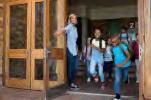
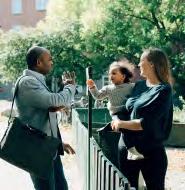
Picture 4:
A: Hello, Sofia!
B: Hello, Mommy!

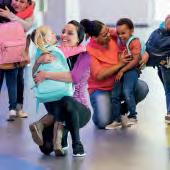
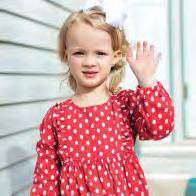

C: Hello, Miguel!
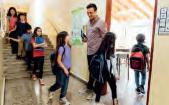
D: Hello, Mommy!

10 10 1 LOOK AND SAY. 2 1.12 LOOK AND LISTEN. 3 MARK YOUR FAVORITE PICTURE. 4 SCHOOL BUS PLAY. 1 1.13 HELLO! GOODBYE! SING AND MOVE. 2 MAKE. 3 SHOW AND LESSON 6 • REAL WORLD HELLO AND GOODBYE M01 Little Friends and Heroes SB1 GLB 95524.indd 10 4/4/22 4:40 PM 8 1 1.14 LISTEN AND MARK. 2 COLOR YOUR STAR. 1 POINT AND SAY. 2 TRACE. LESSON 6 • REAL WORLD HELLO AND GOODBYE M01 LLittle Stars and Friends WB1 GLB 95494.indd 8 4/4/22 10:53 AM Hello! Hello! Goodbye! Goodbye! Lesson 6 • Real world Hello and goodbye Student’s Book Workbook
• to consolidate unit language and themes in a real-world context
Recycled language
GSE Learning Objective
Materials
34
• Can recognize a few basic words and phrases about a familiar topic. Future Skills • Social awareness
• Mickey Mouse puppet
Book time Hello
0.1 Greet students and sing the Hello song.
Circle time
Lesson summary
These pictures show different greetings and partings in a typical day. At the start of the school year, children often feel reluctant to leave their parent or carer. We are acknowledging this in the first and third picture. It’s OK to feel sad when a parent/carer leaves. The second picture reflects a positive experience of being welcomed to school by a caring teacher. The fourth picture reminds children of how happy they will be to see their parents/carers at the end of the day.
• Make Mickey come out of his home and greet you and the students.
• Look at Mickey and say Hello. Make him respond, then turn away and say Goodbye in a sad voice.
• Point to students to show Mickey that he has friends.
Look, Mickey … your friends. Look at (Anna) and (Georgio).
• Have Mickey happily greet students.
• Hold up your Student’s Book, point to each picture, and say Hello? Goodbye?
Is he/she happy?
Observing and interpreting a picture and its context are important critical-thinking skills, which help students relate to their own environment and begin making sense of the wider world.
Student’s Book p10
1 Look and say.
• Have students look at the pictures in their Student’s Books and say any words they know (hello, goodbye, green, happy, friendly).
2 1.12 Look and listen.
• Play the audio.
• Have students follow the listening path with their fingers as they listen.
• Play the audio again, pausing it after each section. Have students repeat hello and goodbye.
3 Mark your favorite picture.
Introduce I like … and favorite by using expressive mime.
• Act as if you are thinking and then point to the last picture and smile.
I like this picture! They’re happy. Which picture do you like?
• Help students think, decide, and mark the picture they have chosen. They may just copy your answer, but they will grow to understand the concept of I like …
4 School bus Play.
• Arrange the chairs like seats on a bus, with your chair at the front. Say Look, it’s a bus!
• Mime driving the bus, then stop the bus. As students get on the bus, say Hello, (Anna)! to each child. As they sit down, encourage them to be friendly and say Hello, (Carlos)! to each other.
• Mime driving again, then stop the bus and say School! We’re at school!
• Let students get off the bus and say Goodbye, (Jack) to each child. Encourage them to say goodbye to each other.
Social awareness: Being friendly and polite makes a big difference in how people perceive us and how we perceive them.
Act out the situations in the pictures, e.g., point to the man in the first picture. Wave goodbye and have students reply.
Workbook p8
1 Point and say.
• Help students decide what is being said in each picture.
2 Trace.
• Point to the girl saying hello and waving goodbye in the first and second pictures.
• Show students how to trace the line between the two pictures with a pencil, then repeat for the pictures below.
Goodbye
0.2 Sing the Goodbye song.
35
Lesson
Main GSE Learning Objective





































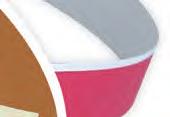




























































1.13 Hello! Goodbye!














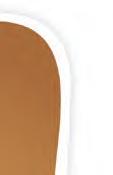





Hello, I’m Ella. Hello! Hello! Hello, I’m Danny. Hello! Hello! Hello, hello, hello! Hello, hello, hello!
Goodbye, Ella! Goodbye! Goodbye! Goodbye, Danny! Goodbye! Goodbye! Goodbye, goodbye, goodbye! Goodbye, goodbye, goodbye!
Hello. I'm ... Hello, Hello. Hello, I'm ... Hello! Hello! Hello, hello, hello! Hello, hello, hello! Goodbye, ... Goodbye! Goodbye! Goodbye, ... Goodbye! Goodbye! Goodbye, Goodbye, Goodbye! Goodbye, Goodbye, Goodbye!

































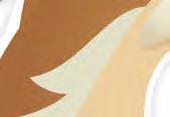
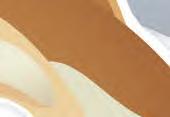
































1.14 Hello! Hello! Goodbye! Goodbye! I’m happy! I’m happy! Green! Green!











11 LOOK AND SAY. 2 1.12 LOOK AND LISTEN. 3 MARK YOUR FAVORITE PICTURE. 4 SCHOOL BUS PLAY. 1 1.13 HELLO! GOODBYE! SING AND MOVE. 2 MAKE. 3 SHOW AND TELL. 4 STICK. MAKE LESSON 7 • REVIEW M01 Little Friends and Heroes SB1 GLB 95524.indd 11 4/4/22 4:40 PM 9 REMEMBER 1 1.14 LISTEN AND MARK. 2 COLOR YOUR STAR. LESSON 7 • REVIEW M01 LLittle Stars and Friends WB1 GLB 95494.indd 4/4/22 10:53 AM Lesson 7 • Review Make and Remember
aims • to review the unit language through project-based learning • to make a project linked to the theme of the unit
Recycled language • hello, goodbye, I’m (Danny), I’m happy, green, I’m friendly
Can
Persistence
growth
Social awareness Materials
Sticker
Press-outs
Student’s Book Workbook
•
follow basic instructions to color, draw, or make something, if spoken slowly and clearly. Future Skills •
and
•
•
(Dopey) •
• Mickey Mouse puppet
36
Hello
0.1 Greet students and sing the Hello song.
Circle time
• Make Mickey come out of his home and greet you and the students.
• Show students your Student’s Book and look through the whole of Unit 1 together.
• Make Mickey point to pictures and say words and phrases. Pause before Mickey speaks so that students can speak first.
• Show admiration at how smart Mickey and the students are and at how much they can remember.
can then use their masks to role-play being one of the dwarfs in the story, using their new language skills
(Hello/Goodbye) to have fun in an imaginative way. Putting on a mask and pretending to be someone else can help with confidence in speaking. When we integrate language with movement and simple dramatic play, we begin to learn to speak in real and imagined contexts.
2 Make.
• Help students press out and make the dwarf mask.
Persistence and growth: The project lessons in My Disney Stars and Friends encourage students to maintain effort, attention, and motivation by making a fun product which can then be used to practice the unit language in a variety of ways.
3 Show and tell.
Book time
Student’s Book p11
1 1.13 Hello! Goodbye!
Sing and move.
• Play the video and join in with the actions on the screen.
• Play the video again. Students join in doing the actions and singing the song if they can.
• If you can’t play the video in class, play the audio version of the song instead and do the actions from Lesson 2.
About the project
This project develops students’ fine and gross motor skills as they press out and put on their Happy masks. They
• Ask half of the students in the class to wear their Happy masks. As Happy, they will greet the other students and tell them who they are.
• Have them wave at the other students and say Hello! I'm Happy! together. Have the other students wave back and say Hello!
• Have all the students with masks say Goodbye! and take off their masks. Have all the other students say Goodbye! as they do this.
• Repeat the activity with the other half of the class putting on the Happy masks.
There is no need for complete accuracy at this stage – the important thing is having fun and speaking a very small amount of English together.
Remember to praise students for being good group members, even if they are not contributing orally but are supportive or admiring of their more vocal friends.
Social awareness: Choral speaking helps students interact with their friends and enables shy students to join in without feeling exposed.
Ask students their names. Say Hello! What’s your name? Students can answer either with their own names or to put on their masks and say I'm Happy if they prefer.
4 Stick.
• Help students find and stick the star-shaped Dopey sticker as a reward for completing the unit.
Persistence and growth:
Workbook p9
1 1.14 Listen and mark.
• Play the first part of the audio (Hello! Hello!), then pause it and check to see that students can point to the correct picture.
• Help them mark the correct picture (Snow White).
• Repeat for the rest of the audio.
2 Color your star.
• Tell students they have done a good job and they can color their star.
Goodbye
0.2 Sing the Goodbye song.
You can now do the Unit 1 Disney movie lesson (see Teacher's Book page 38).
37
Language
• hello, goodbye, green, I’m happy, I’m friendly
• fish, daddy, school, teacher (preview)
Materials
• Unit 1 Picture Cards (hello, goodbye)
• Mickey Mouse puppet
• drawing paper and crayons
Hello
0.1 Greet students and sing the Hello song.
VideoLanguagescript
Look, it’s Nemo. It’s Nemo and his daddy. It's time for school, Nemo.
Nemo is happy! He's happy, happy, happy!
Wow! Look at all the fish! Wow! Look! A big fish! A green fish! Lots of green fish!
Nemo is friendly. Oh, look, it’s the teacher! Hello! Hello! Hello, teacher! Hello, Nemo!

Goodbye, Nemo! Goodbye, Daddy! Goodbye, Nemo! See you later! Let’s go!
Nemo is happy!
Circle time
• Make Mickey come out of his home and greet you and the students.
• Make Mickey hold up the Picture Cards and show students.
• Have students call out the words hello and goodbye.
• Make Mickey praise them. Good job! Yes! That’s right!
• Show the movie still of the video clip. Look! It’s Finding Nemo! Let’s watch!
When you talk to students about the clip, have them join in with any of the words they know.
• Play the clip and let students watch carefully. Good? (Yes/No)
• Have students answer Yes! (or No)
• Start the clip again, but pause at 00.53: Nemo and his daddy going to school. Who’s this? (Nemo) Who’s this? (Daddy) Is Nemo happy? (Yes)
• Pause at 01.41: the green fish. What color are the fish? (green) Yes, green!
• Pause at 02.12: Nemo meeting his new friends. Is Nemo friendly? (Yes)
• Pause at 02.34: the teacher arriving. Who’s this? (It’s the teacher!)
• Pause at 03.29: Daddy waving goodbye. What is Daddy saying? (Goodbye, Nemo!)
• Play the clip again, without pausing.
Video time
About the clip
Nemo is a young fish and today is his first time at school. He and his dad set out, being careful to avoid danger on the way. Nemo is happy to see his school. Nemo is friendly and greets all the other sea creatures there. Their teacher is a large ray fish and for their first lesson, he takes his students on an adventure to see the wonders of the ocean. Nemo says goodbye to his daddy, knowing that he will see him again at the end of the school day.
• Hand out drawing paper and crayons. Draw Nemo.
• Let students draw anything they wish from the clip.
Goodbye
0.2 Sing the Goodbye song.
Finding Nemo
38
Disney movie lesson











































































































































































































































































































































































































































































































































































